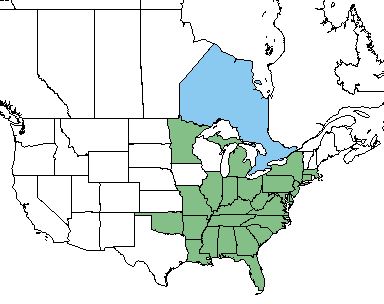Difference between revisions of "Angelica venenosa"
(→Ecology) |
|||
| Line 33: | Line 33: | ||
''A. venenosa'' is found in dry forests and woodlands, woodland borders, longleaf pine sandhills, hammocks, and prairies. <ref name= "Weakley 2015">Weakley, A. S. (2015). Flora of the Southern and Mid-Atlantic States. Chapel Hill, NC, University of North Carolina Herbarium. </ref> | ''A. venenosa'' is found in dry forests and woodlands, woodland borders, longleaf pine sandhills, hammocks, and prairies. <ref name= "Weakley 2015">Weakley, A. S. (2015). Flora of the Southern and Mid-Atlantic States. Chapel Hill, NC, University of North Carolina Herbarium. </ref> | ||
===Phenology=== <!--Timing off flowering, fruiting, seed dispersal, and environmental triggers. Cite PanFlora website if appropriate: http://www.gilnelson.com/PanFlora/ --> | ===Phenology=== <!--Timing off flowering, fruiting, seed dispersal, and environmental triggers. Cite PanFlora website if appropriate: http://www.gilnelson.com/PanFlora/ --> | ||
| + | Unusual features of ''A. venenosa'' varieties found in dry sandhill communities in the Fall Line Sandhills include basal leaves that lay directly on the ground, small leaflets, and coarse, more equilateral toothing of the leaflets. <ref name= "Weakley 2015"/> | ||
<!--===Seed dispersal===--> | <!--===Seed dispersal===--> | ||
<!--===Seed bank and germination===--> | <!--===Seed bank and germination===--> | ||
Revision as of 17:08, 16 May 2018
| Angelica venenosa | |
|---|---|

| |
| Photo by the Atlas of Florida Plants Database | |
| Scientific classification | |
| Kingdom: | Plantae |
| Division: | Magnoliophyta - Flowering plants |
| Class: | Magnoliopsida - Dicots |
| Order: | Apiales |
| Family: | Apiaceae |
| Genus: | Angelica |
| Species: | A. venenosa |
| Binomial name | |
| Angelica venenosa (Greenway) Fernald | |

| |
| Natural range of Angelica venenosa from USDA NRCS Plants Database. | |
Contents
Taxonomic Notes
Synonyms: A. villosa (Walter) Britton, Sterns, & Poggenburg
Varieties: none
Description
A. venenosa is a perennial forb/herb of the Apiaceae family native to North America and introduced in Canada. [1]
Distribution
A. venenosa can be found in the eastern half of the United States, ranging from Oklahoma and Minnesota to Florida and Massachusetts. It has also been introduced in Canada, specifically in Ontario. [1]
Ecology
Habitat
A. venenosa is found in dry forests and woodlands, woodland borders, longleaf pine sandhills, hammocks, and prairies. [2]
Phenology
Unusual features of A. venenosa varieties found in dry sandhill communities in the Fall Line Sandhills include basal leaves that lay directly on the ground, small leaflets, and coarse, more equilateral toothing of the leaflets. [2]
Conservation and Management
Cultivation and restoration
Photo Gallery
References and notes
- ↑ 1.0 1.1 USDA Plant Database https://plants.usda.gov/core/profile?symbol=ANVE
- ↑ 2.0 2.1 Weakley, A. S. (2015). Flora of the Southern and Mid-Atlantic States. Chapel Hill, NC, University of North Carolina Herbarium.